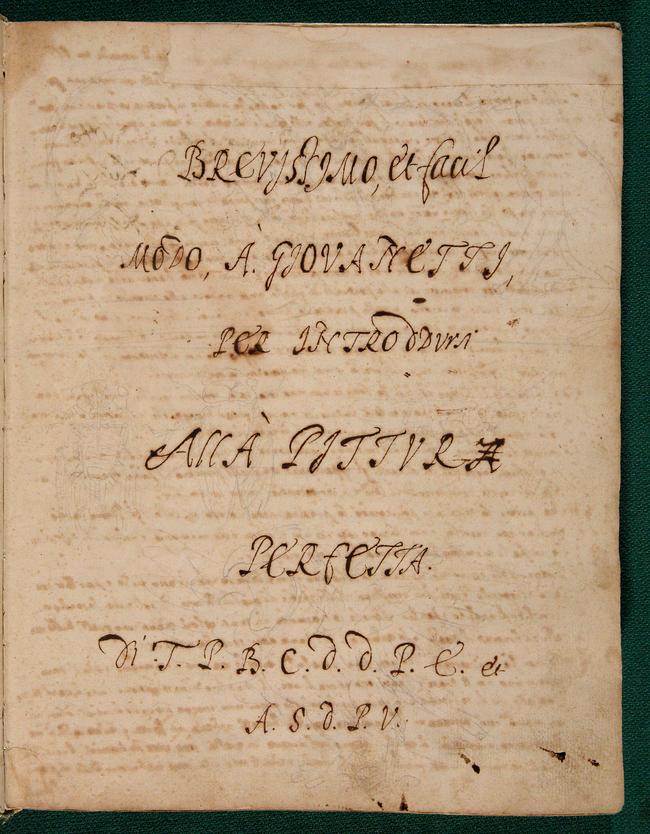
Naples, Universita degli Studi di Napoli Federico II. Centro di Ateneo per le Biblioteche-Biblioteca di Area Umanistica
, Datable to the late 16th century
377 numbered chapters without headings 94 illustrations
Table of Contents
Provenance from Mantua documented by watermark and additional texts contained in the volume
Rediscovered in 2012, this manuscript is similar to late 16thth century Florentine manuscripts, such as f2 and fm2, although it does not derive directly from any of them.
See detailed description and analysis 
| Analysis Unknown until 2012 when Angela Ceresuolo rediscovered it in a private collection in Naples, manuscript NU is close to Florentine manuscripts of the late 16th century, such as F2 and FM2, although it does not derive directly from any of them. Most likely this group of similar manuscripts derives from a common source that is today either lost or unidentifiable. Like these early Florentine copies, NU has numbered chapters without headings and a Table of Contents at the end (fols. 36r-39r), which in NU is titled “Indice di tutto, che nel trattato si contiene.” In addition, NU is close to early Florentine copies such as F2 and FM2 for the irregularities in the numbering of chapters that they all present: although the text in these copies is divided in 377 chapters, it is numbered with only 368 chapters. This same misnumbering appears also in L1, which however is certainly later than F2, FM2, and NU: a note in L1 (fol. 97r) explains the misnumbering. On the verso of the inside cover it is reported “Il Cont? modo è copiato in tutto e per tutto da Leonardo d’Avinci [sic] perfetto maestro di tal professione.” The images of NU are similar those contained in F2 and FM2, although a couple of images (fols. 16r and 18r) include details that are not present in early Florentine copies but are documented in Melzi’s original compilation (VU). A notable addition in NU is a sentence at the end of Chapter 365 (fol. 35v) on the depiction of folders in garments, which includes a reference to the Roman painter Domenico Fetti (1589-1623), who was active in Venice and at the Gonzaga court in Mantua between 1611 and 1621. In this note Leonardo recommends that folders be painted in a natural way, taking into account the different ways fabrics create folders; the anonymous scribe added a note mentioning that Fetti did not follow Leonardo’s recommendation “even though he [Fetti] did very well in matters of colors and of telling stories.” Today the manuscript has a seventeenth-century parchment cover and is bounded together with two additional texts that are unrelated to Leonardo’s text but that are germane to establish the provenance of NU from Mantua. The texts are: “Trattato del sangue di Cristo di Francesco Tartalone Dottore e Canonico di S. Andrea di Mantova,” which is dedicated to “Signor Tullio Petroianni, dignisimo Preposito di Santo Benedetto, Primicerio di Santo Andrea, Conte della Villa di Santo Secondo e Consigliere della A. Ser.ma di Mantova” and dated 25 November 1599. The second text is a report to Charles I, duke of Mantua, from his ambassador to the Spanish court,w hich is title “Relazione del Conte Alessandro Striggi al Serenissimo Carlo I, Duca di Mantova, di Monferrato, di Nevers, Umena e Rethel l’anno 1631, della sua Ambasceria di sei anni in Spagna e dello stato presente di quella Corona e Corte.” |
| History The early ownership of NU is unknown. In the 20th century this manuscript is documented in a private collection in Napels, although it is unknown when it arrived in Naples and in that private collection. In 2016 the University of Naples Federico II acquired it for its library, where the manuscript is currently kept. |
| Physical Description 1-40, 26.5 x 21.3 cm , fols. 36r-39r Table of Contents (“Indice di tutto, che nel trattato si contiene”.) |
| Watermark The manuscript has two watermarks. One represents a crossbow inside a circle with a lily above and it is documented in Florence around 1560 (“Crossbow D”). Another represents an eagle inside a circle with a crown above it which is very similar to Briquet 209 (Verona 1582-1596) and also documented in Ferrara around 1602. |
| Bibliography Angela Cerasuolo, Anna Sconza, “Un manoscritto inedito del Trattato abbreviato in collezione privata napoletana, in Raccolta vinciana 35 (2013), pp. 279-298 (also for a discussion of the manuscript's watermarks). Alfredo Buccaro, “ Il ‘codice fridericiano’ apografo del Trattato della Pittura,” in Leonardo e il Rinascimento nei codici napoletani. Influenze e modelli per l’architettura e l’ingegneria, ed. Alfredo Buccaro e Maria Rascaglia (Naples: CB Edizioni Grandi Opere, 2020), pp. 79-82. |
| For reproductions contact: http://www.sba.unina.it/ |